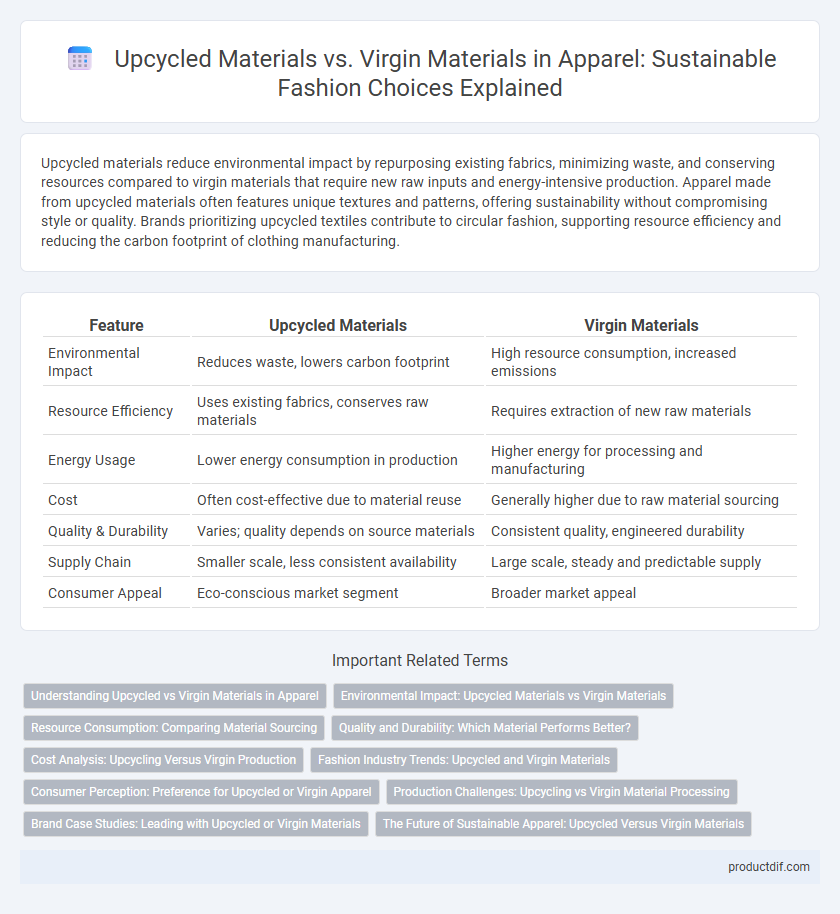Upcycled materials reduce environmental impact by repurposing existing fabrics, minimizing waste, and conserving resources compared to virgin materials that require new raw inputs and energy-intensive production. Apparel made from upcycled materials often features unique textures and patterns, offering sustainability without compromising style or quality. Brands prioritizing upcycled textiles contribute to circular fashion, supporting resource efficiency and reducing the carbon footprint of clothing manufacturing.
Table of Comparison
| Feature | Upcycled Materials | Virgin Materials |
|---|---|---|
| Environmental Impact | Reduces waste, lowers carbon footprint | High resource consumption, increased emissions |
| Resource Efficiency | Uses existing fabrics, conserves raw materials | Requires extraction of new raw materials |
| Energy Usage | Lower energy consumption in production | Higher energy for processing and manufacturing |
| Cost | Often cost-effective due to material reuse | Generally higher due to raw material sourcing |
| Quality & Durability | Varies; quality depends on source materials | Consistent quality, engineered durability |
| Supply Chain | Smaller scale, less consistent availability | Large scale, steady and predictable supply |
| Consumer Appeal | Eco-conscious market segment | Broader market appeal |
Understanding Upcycled vs Virgin Materials in Apparel
Upcycled materials in apparel are created by repurposing pre-existing fabrics or garments, significantly reducing waste and environmental impact compared to virgin materials, which are produced from raw, untreated fibers. Virgin materials often require extensive water, energy, and chemical-intensive processes, contributing to higher carbon emissions and resource depletion. Choosing upcycled fabrics supports sustainable fashion by minimizing landfill contributions and promoting circular economy principles in garment production.
Environmental Impact: Upcycled Materials vs Virgin Materials
Upcycled materials in apparel significantly reduce environmental impact by minimizing textile waste and lowering carbon emissions compared to virgin materials, which require extensive resource extraction and energy consumption. The production of virgin fibers such as cotton and polyester involves high water usage, pesticide application, and greenhouse gas emissions, whereas upcycled fabrics repurpose existing materials, conserving natural resources and reducing landfill contributions. Choosing upcycled materials supports circular fashion practices, promoting sustainability and reducing the apparel industry's ecological footprint.
Resource Consumption: Comparing Material Sourcing
Upcycled materials reduce resource consumption by repurposing existing textiles, minimizing water use and energy compared to virgin materials, which demand extensive raw resource extraction and manufacturing processes. Virgin materials like cotton require significant land, water, and chemical inputs, contributing to higher environmental footprints. Utilizing upcycled fabrics supports sustainable apparel production by conserving natural resources and reducing waste.
Quality and Durability: Which Material Performs Better?
Upcycled materials often exhibit comparable quality and durability to virgin materials when processed with advanced techniques, making them a sustainable alternative in apparel production. Virgin materials traditionally provide consistent performance due to their untouched fibers, ensuring predictable strength and longevity in garments. However, innovations in recycling and textile engineering are improving the durability of upcycled fabrics, narrowing the performance gap with virgin materials while reducing environmental impact.
Cost Analysis: Upcycling Versus Virgin Production
Upcycled materials in apparel production typically reduce raw material costs by reusing existing fabrics, leading to lower expenses compared to virgin materials, which require extensive resource extraction and processing. Virgin production incurs higher costs due to energy-intensive manufacturing, chemical treatments, and new fabric sourcing, impacting overall pricing and environmental footprint. Cost analysis reveals that upcycling not only lowers material expenditures but also aligns with sustainable practices, offering competitive pricing advantages in eco-conscious markets.
Fashion Industry Trends: Upcycled and Virgin Materials
Upcycled materials in the fashion industry reduce waste by repurposing existing textiles and garments, aligning with growing consumer demand for sustainable apparel. Virgin materials, typically sourced from new cotton, polyester, or wool, provide consistency and quality but contribute significantly to environmental impact through resource-intensive production. Emerging trends emphasize hybrid approaches that combine upcycled fibers with virgin fabrics to balance eco-conscious innovation and durability in fashion collections.
Consumer Perception: Preference for Upcycled or Virgin Apparel
Consumer perception increasingly favors apparel made from upcycled materials due to growing environmental awareness and demand for sustainable fashion. Studies show that upcycled apparel is often viewed as more ethical and unique, attracting eco-conscious shoppers seeking to reduce textile waste. However, some consumers still prefer virgin materials for perceived quality and durability, highlighting the importance of balancing sustainability with performance in apparel design.
Production Challenges: Upcycling vs Virgin Material Processing
Upcycled materials in apparel production often face challenges such as inconsistent quality and limited supply, requiring specialized sorting and cleaning processes to ensure fabric integrity. Virgin material processing, while more standardized, involves significant resource consumption and environmental impact due to intensive chemical treatments and energy use. Balancing production efficiency with sustainability goals remains a critical hurdle in integrating upcycled materials at scale.
Brand Case Studies: Leading with Upcycled or Virgin Materials
Patagonia's commitment to sustainability is evident through their extensive use of upcycled materials, including recycled wool and nylon, which reduce environmental impact while maintaining high-performance standards. In contrast, luxury brand Gucci emphasizes the use of virgin materials, sourcing premium raw cotton and leather to uphold exclusivity and superior craftsmanship. Both approaches highlight distinct brand philosophies: Patagonia leads with eco-conscious innovation, whereas Gucci prioritizes tradition and luxury, demonstrating that material choices significantly shape brand identity and consumer perception in the apparel industry.
The Future of Sustainable Apparel: Upcycled Versus Virgin Materials
Upcycled materials in apparel production significantly reduce waste by repurposing discarded fabrics, lowering carbon emissions compared to virgin materials derived from resource-intensive processes. Virgin materials typically demand more water, energy, and chemicals, contributing to environmental degradation and increased greenhouse gas emissions. The future of sustainable apparel increasingly favors upcycled materials as brands and consumers prioritize circular economies and eco-friendly supply chains.
Upcycled Materials vs Virgin Materials Infographic

 productdif.com
productdif.com